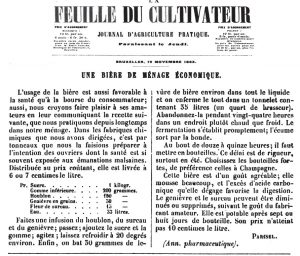A French (and Belgian) beer for factory workers and farm hands
 The French-speaking part of this world has a lot of beer history yet to be discovered. An example is an old Belgian magazine that I found, La feuille du cultivateur, published in Brussels as a ‘journal d’agriculture pratique’, which means: journal of practical agriculture.
The French-speaking part of this world has a lot of beer history yet to be discovered. An example is an old Belgian magazine that I found, La feuille du cultivateur, published in Brussels as a ‘journal d’agriculture pratique’, which means: journal of practical agriculture.
There’s some stuff in it on the culture of hops, but in the edition of 19 November 1863, my attention was drawn to ‘une bière de ménage économique’, which means: a cheap household beer. According to a brief mention at the end, it was copied from a magazine called Annuaire pharmaceutique, published in Paris by one Louis-Victor Parisel. And then it turns out that we have ended up at the nastiest episode of the industrial revolution: it was a beer given by a factory owner to his workers.
Let’s translate this one in full:
A cheap household beer
The usage of beer is as favourable to health as it is to the drinker’s wallet; also we think we are doing beer lovers a favour by communicating the following recipe, that we have been using in our household for a long time. In the chemical factories that we have led, we had it made by barrels, for our workers whose health is so often exposed to unhealthy emissions.
Distributed at cost, it is sold at 6 or 7 centimes a litre.
Sugar – one kilogram
Inferior gum – 200 gram
Hops – 150 gram
Juniper berries – 30 gram
Elderberry flowers – 15 gram
Water – 35 litres
Make an infusion of hops, elderberry and juniper; sieve; add the sugar and gum; stir; let it cool down to about 20 degrees Celsius. Finally, stir 30 grams of beer yeast throughout the liquid and enclose the whole in a small barrel of 35 litres (a brewer’s quart). Leave it for about 24 hours in a place that is warm rather than cold. Fermentation will start promptly; the foam will come out through the hole.
After 12 to 15 hours, put it in bottles. This time is needed, especially in summer. Take strong bottles, preferably Champagne bottles.
This beer has a pleasant taste; it foams a lot, and the excess of carbonic acid that it gives off stimulates digestion. The juniper and elderberry can be diminished or left out altogether, following the taste of the amateur brewer. It is drinkable after seven of eight days in the bottle. Its prix is less than 10 centimes a litre.
 What catches the eye is of course the total absence of grains in this recipe, and the fact that it isn’t boiled except for the infusion. In fact, we’re talking about fermented sugar water with a flavour, at 1.4 % ABV. If the hops are infused well, an IBU of 50 could be reached, which is quite bitter.
What catches the eye is of course the total absence of grains in this recipe, and the fact that it isn’t boiled except for the infusion. In fact, we’re talking about fermented sugar water with a flavour, at 1.4 % ABV. If the hops are infused well, an IBU of 50 could be reached, which is quite bitter.
It remains to be seen whether the factory workers really were all that pleased with this little brew. With some fantasy, an image comes to mind of the smiling posh factory owner in top hat, providing the workers, clad in rags, a rusty mug of this crude goo, and those powerless paupers even were supposed to be grateful…
And on the other hand, this recipe appeared in a Belgian agricultural magazine, so it was probably intended as a drink for farm workers here. But wait: weren’t the farm hands supposed to be given wonderful thirst-quenching saison instead of this cheap muck? More on that shortly.






Leave a Reply